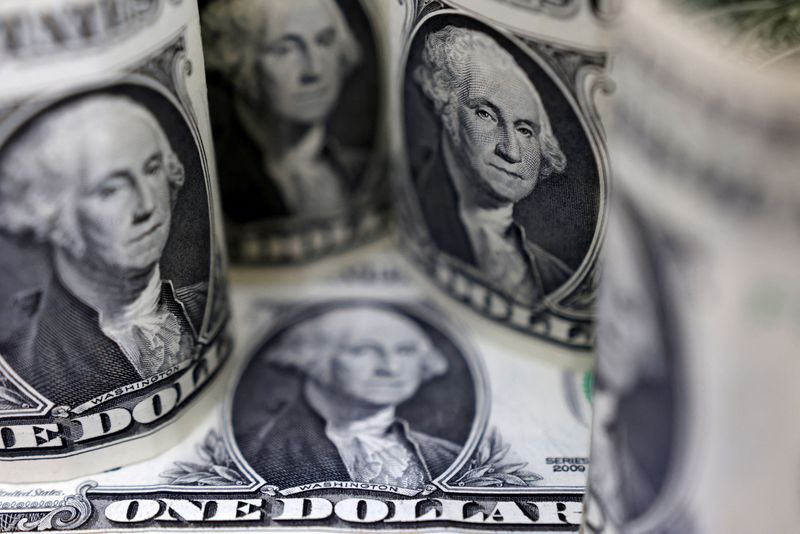Column-The peculiar ‘no show’ from US cash funds: Mike Dolan
2024.10.30 03:23
By Mike Dolan
LONDON (Reuters) – A flood of money was expected to cascade from U.S. cash funds to riskier assets as interest rates began to tumble. But so far, this flood has been missing in action, raising the question of whether this is a sign of extreme caution, plain inertia or something else.
The brimming bunkers of cash held by U.S. households and companies have never been higher, inflated by monetary and fiscal responses to the pandemic shock and then cosseted by rising interest rates.
It was presumed that tempting this cash back into bonds and stocks would only require an initial Federal Reserve interest rate cut, with the promise of an extended easing cycle and plain sailing ahead for the economy.
Both scenarios seem to be materializing, and yet cash coffers are still swelling.
Assets under management at cash-like U.S. money market funds – which are invested mostly in short-term government bills with maturities of less than a year – topped $6.5 trillion for the first time this month.
That’s some $200 billion higher than just before the Fed’s 50 basis point rate cut last month, almost $1 trillion higher than this time last year, and twice the pre-pandemic level five years ago.
Of course, the ongoing expansion of money fund assets over the past 18 months is partly just reinvestment, as these funds have enjoyed the heftiest returns in almost 20 years, as well as a whoosh of inflows from checkable deposits following the Silicon Valley Bank bust in the spring of 2023.
That said, signs remain scant that these cautious savers will be chasing riskier returns any time soon.
And what’s the rush? The returns offered by these funds are still attractive, especially if you’re wary of any economic or political disturbances ahead.
Even though 12-month bills have shed roughly a full percentage point in yield over the past quarter, they still offer almost 4.3% – more than current two-year Treasury notes. And the latter have jumped by 30 basis points in recent weeks as signs that the economy is heating up again have cooled expectations for further near-term Fed easing.
INEVITABLE TAILWIND?
The Fed is still expected to lop off at least 130bp from policy rates by the end of next year, so most analysts still expect these savers will need to shift their calculus eventually.
A first baby step for money fund holders may be on the U.S. Treasury curve: to lock in two-year fixed coupons at roughly the same rate as current average bill rates – before the Fed pulls the carpet out from bill returns over the next year.
Investors with more confidence about the near-term outlook may instead opt to go straight to higher-yielding corporate credit or even stocks.
Apollo Chief Economist Torsten Slok reckons that corporate credit and higher-yielding fixed income will benefit as cash in money funds seeks to take on more risk and households shed their unusually high government bond holdings.
Slok pointed out that since 2021, households holding “TreasuryDirect” accounts – where you can buy and sell government bonds – have increased nearly six-fold to 4 million.
That figure may be down from peaks closer to 5 million last year. Yet, almost six weeks after the Fed started cutting rates, the cash mountain appears undisturbed.
PRE-CAUTIONARY LIQUIDITY
Perhaps many of these money fund investors simply aren’t as interest rate sensitive as many previously believed.
In a special report this month, Barclays analyst Joseph Abate and team dug deeper into the cash question. They pointed out that what’s even more head-scratching than the inertia in money funds is the still huge corporate and household stash in even lower-yielding checkable deposits.
Total deposit holdings have surged as high as $7.1 trillion, which represent 7-9% of overall financial assets for both groups – the highest share in 34 years.
These accounts yield around 3% or less on a “blended” basis, gleaned from a range of providers and including certificates of deposit and time deposits.
The big question is why firms and individuals have been willing to forgo almost 200bp of return by keeping their money in these checking accounts instead of moving it to money funds – never mind piling into risky assets.
Abate notes that roughly $1 trillion of checkable deposits did shift to money funds over the past year and some of this is clearly interest rate sensitive.
But he thinks it may take another six months for these savvy investors to emerge from money funds into investment grade credit and doubts the shift to equity makes sense based on current valuations and risk premiums.
As for the mountain of deposits, he reckons these may just reflect “a shift in liquidity preferences that has increased the demand for precautionary safety buffers”. This could be driven by the regional banking blowup last year or even memories of money funds “breaking the buck” 15 years ago.

Either way, the cash stash may go to work eventually, but don’t hold your breath.
The opinions expressed here are those of the author, a columnist for Reuters
(by Mike Dolan; Editing by David Gregorio)








